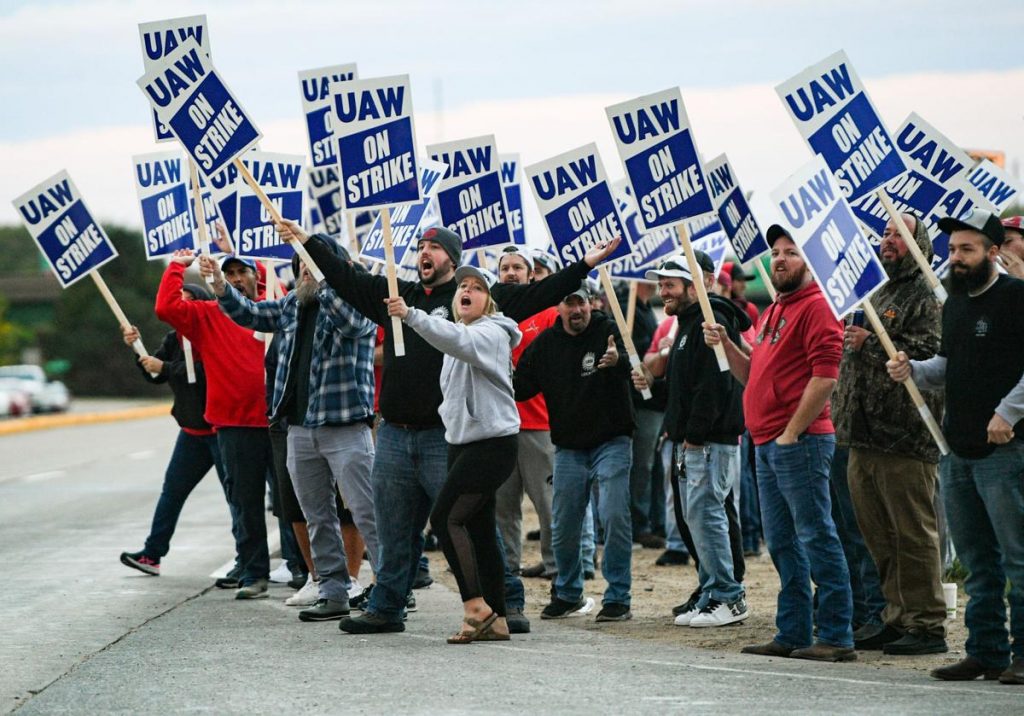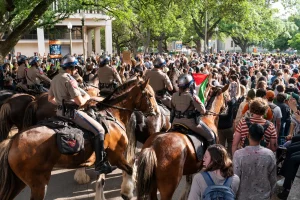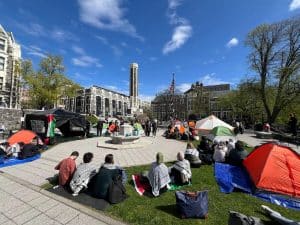The strike is one of the most important weapons that the working class has against the ruling class.
That’s why strikes are so hated and feared by capitalists and the Democratic and Republican Parties that look after their interests. It’s why there are so many laws and government bodies with the power to restrict when, whether, and how unions are “allowed” to strike.
In the last few months we’ve seen an important uptick in strikes with over 1,000 workers. Still, we’re a far cry from the last wave of massive strikes of the 1970s.
But if strikes are such powerful and feared weapons, why has the number of large strikes plummeted since the 1980s — grinding to historic lows in the last few years? Above all, blame the Democratic Party.
If we want more strikes, bigger strikes, and more militant strikes, we need a political fight in our unions to break with the Democrats.
An Alliance against the Rank and File
The strike waves of the 1930s in the U.S. have become almost legendary for the Left today. Immortalized in books like Teamster Rebellion, it was an era of intense worker struggle, with many thousands of workers in key industries striking en masse.
That upsurge was driven, above all, by rank-and-file struggle, as Mike Davis points out in Prisoners of the American Dream. But over the next few decades, the union leadership of the new CIO federation fought to shut down rank-and-file organizing and power — a task that linked that leadership to the Democratic Party.
In the mid-1930s, at the dawn of the CIO, the link with the Democrats was already being forged. Roosevelt and the Democrats were scrambling to control the upsurge of worker struggles. One key weapon for doing that was legislation. 1934 brought the Wagner Act, or the National Labor Relations Act, which officially recognized unions and protected their activity — a move to help channel the union struggle and bring it into the orbit of Democratic Party influence as a voting bloc. That alliance was one, as Sharon Smith points out, that CIO labor leaders were very happy to leap at, pushing workers to vote for and support Democrats.
That alliance between union leaders and Democrats reached a tipping point during World War Two and the years just after. The leaders of the CIO and AFL federations agreed to try to enforce Roosevelt’s request: no strikes during the war. The agreement gave CIO union leaders the chance to consolidate national power over their union locals, precisely because they needed to be able to enforce the no-strike deal with the president. That process was helped along by the Communist Party leadership, which threw its support behind both the CIO bureaucracy and the Democratic Party.
Union leaders, then, had to be the “economic police” over their own unions to shut down the rank-and-file struggle that had surged in the 1930s — a process helped along by the establishment of pattern bargaining, setting wages, for example, in an entire industry like steel rather than fighting workplace by workplace.
By the end of the war, the concentration of power at the top of the CIO was well underway. The leadership of the UAW, as Kim Moody points out in An Injury to All, pushed to massively centralize the union, carrying “top-level decisions all the way down to the local level. Staff members were disciplined to carry out administration policies and denied the right to run against administration candidates at any level.” That meant central control even of union local newspapers.
And Moody argues that a key force consolidating power at the top of unions — away from the rank and file — was the rise of multi-year contracts. During the 1930s, union contracts, where they existed, typically lasted a year. But in the years after WWII, union leaders pushed for multi-year contracts. These served both union leaders and their Democrat allies by disciplining shop-floor struggle under the leadership of union heads and guaranteeing “labor peace” for extended periods of time.
Those kinds of contracts increasingly contained no-strike clauses. Explicit no-strike clauses were rare in the 1930s. By the late 1940s, they had started to become boilerplate. The no-strike clause vested more power in union leaders, who in turn, were trying to serve up “labor peace” to the Democratic Party’s allies in exchange for influence. What’s more, the 1947 Taft-Hartley act deeply restricted the use of the strike. It outlawed solidarity strikes, and consolidated a national, homogeneous legal framework for enforcing no-strike clauses.
Another key factor to consolidate power of union leaders was the post-war anti-Communist crusade inside unions. The Taft-Hartley Act required unions to expel and denounce communist members. This was not just accepted by CIO national leadership; Moody shows how it was executed with relish. The label “communist” was used to silence any critique of union leaders by the rank-and-file.
With these changes, the basic terrain of struggle for unions was shifting away from rank and file struggle on the shop floor, and into capitalism’s legal system.
Helping to power the shift, between 1934 and 1947 Democrats established a system of labor arbitration — a legal framework for resolving the struggle between workers and management. The arbitration system put more power in the hands of union staff, and so it helped to blunt rank-and-file struggle by snaring it in a system of red tape and delays. Worker grievances and unfair labor processes had to pass through labor bureaucrats and management-controlled systems of arbitration or the state run NLRB. .
That arbitration system, and more complex multi-year contracts, required an extraordinary increase in the number of union staffers. The apparatus was becoming truly massive. Davis points out in Prisoners of the American Dream: “By 1962, for instance, there were 60,000 full-time, salaried union officials in the United States (one for every 300 workers), as contrasted to 4,000 in Britain (one for 2,000) or 900 in Sweden (one for 1,700).”
In other words, unions were investing a massive amount of funds in precisely the kind of staff whose main concern is working inside the ruling class’s legal system. And that shift of focus was accompanied by the constant push by union leaders to raise money for Democratic Party members running for office and to push union member votes their way, too.
The idea was, and remains, this: if the main arena of struggle is the legal system, unions should focus, above all, on influencing Democrats to make better laws — not using workers’ main weapons against the ruling class.
Wildcats and Bureaucrats
All of this shows that the attack on rank-and-file, militant struggle, and on large strikes, was primarily rooted in the link between union leaders and the Democratic Party.
And yet the period from WWII through the mid-1970s was roiled by mass worker struggle. 1947 alone saw 247 major work stoppages of 1,000 workers or more; by 1952 that number was 470. The 1970s in particular were periods of major wildcat action — with rank and filers rebelling against their leaders’ blunting tactics and walking off their jobs in huge numbers. The number of large strikes in that time nearly reached the post-war numbers.
We see in this period the uneven establishment of the new forms of control over the rank and file. Since unions had already been purged of communists and socialists, that rank-and-file revolt had few real organizational alternatives to the new bureaucratic union structure and its integration into the U.S. legal system.. Moody writes: “In each case, the union was able to ignore the strike movement through its bureaucratic control of the negotiating process or to defuse the strike by getting better economic terms.”
But this meant labor was totally unprepared for the hammer blows that were about to fall. The mid-1970s brought an economic crisis that drove up unemployment and so fundamentally weakened the bargaining position of labor. By the early 1980s, the ruling class was fully on the offensive — launching the neoliberal capitalist policies that would shatter unions and decimate their numbers in the decades to come.
Union leaders had —- with their allies, the Democrats — unwittingly prepared labor to succumb. They had worked together to shatter the initiative of rank and filers and ensure the main field of struggle was the law, not strikes. It’s no coincidence that in the decades after 1980, the number of large work stoppages largely collapsed — from 187 in 1980 to a historic low of just five in 2009, rising to 25 in 2019.
Forty years — and multiple Democratic administrations — after the neoliberal offensive started, the disaster of our union leaders’ strategy is still on full display.
Above All: Cut Ties
In other words, union leaders’ deal with the Democrats has been a deal with the devil.
We need to cut our unions’ ties to the Democrats just to be able to win real bread-and-butter economic concessions. Bosses fear strikes for very good reason; they are one of the most important weapons of workers against them and a key weapon for winning better wages, hours, and working conditions. But labor leaders kowtow to the Democrats and think we should fight in the courtroom, not on the shop floor. So building our capacity to strike will have to come from rank and filers ourselves.
It’s true that, occasionally, our union leaders do call strikes, even large ones. But these exceptions show just how strike-averse our union heads are. 2018 and 2019 saw a modest rise in the number of big strikes from previous years. 2021 seems to continue the trend. These strikes are important, but have to be seen in context. While they return us to the numbers of the early 2000s, they fall short of any year on record before 1998, and are a tiny fraction of the number of big strikes in any year before 1980.
And today, when leaders do call strikes, their ties to the Democratic Party mean those leaders force strikes to play according to the ruling class’s own rules in the legal system. Accepting this fixed carnival game, our leaders usually refuse to try to build roiling solidarity strikes with other unions to cause more serious disruptions to the economy. And they typically refuse to organize against scabs who are crossing picket lines and keeping workplaces running — making it far easier for bosses to replace strikers and therefore for strikes to fail.
So in order to have more, bigger, and more powerful strikes, we badly need rank-and-file organizing — the kind willing to break the law. That means organizing to strike even when there’s a no-strike clause in effect. And it means deying restrictive no-strike laws that have been so dear to the Democratic party — like the Taylor Law in New York State that forbids public sector strikes. In the same way, it will take rank and filers, organizing from below, to spearhead the fight against scabs — keeping up pressure on the bosses by refusing to allow any workers to turn out profits in the midst of a strike.
But allying with the Democratic Party hasn’t only been catastrophic for winning economic concessions. It has also been a disaster by keeping the working class disconnected from the wider, crucial struggles that concern it — like the fight for racial equality and abortion rights.
It’s no secret that organized labor mostly sat on the sidelines last year during the BLM uprising — the biggest social protest movement in U.S. history — though there were some important exceptions. Some unions took part in Strike for Black Lives Day or otherwise expressed support. But large strikes in solidarity were mostly, and strikingly, missing. The Bureau of Labor Statistics notes only eight large strikes last year as a whole, making 2020 the third lowest year in terms of large strikes ever recorded.
Labor leaders by and large couldn’t call on rank and filers to strike against the police and for Black lives. That’s because their allies, the Democrats, were themselves the ones spearheading the violent repression of protesters in major cities across the U.S., while Democrats like Biden came out against calls to defund the police. Yet it’s that division — that refusal of organized labor, across its history in the U.S., to take up racial struggle as its own — that has repeatedly hobbled the labor movement.
Linking organized labor to the wider fights of our class is crucial for the power of the working class to unite its struggles, rather than remaining divided under the attacks of the ruling class.
For example, the fight against U.S. funding of Israel and its slaughter of Palestinians — championed by Democrats and Republicans alike — isn’t just a noble moral stance. The state of Israel receives billions in aid from the U.S., while labor at home is told there isn’t enough money for a minimum wage that could keep up with (currently spiking) inflation. And Israel trains the police that murder Black people, overwhelmingly from the working class, as well as attack strikers.
And access to a free, safe, and legal abortion is one key to the working class’s power and freedom. Yet union leaders are sitting on their hands waiting for the Democrats to save Roe v. Wade, on the very eve of Roe v. Wade’s overturning. Our union leaders have overwhelmingly shown they want to shy away from that wider struggle, all to kowtow to the Democratic Party — despite the utter failure of Democrats to take abortion rights seriously. And yet to unite our class and build our power, we badly need our unions to be part of every fight that affects our class — against imperialism, against misogyny, against racism.
Connecting unions to the wider struggles of our class will have to mean cutting ties to Democrats. That means building militant strikes ready to stop scabs and push for solidarity strikes — without regard for the laws that are designed to blunt and dissipate our power. It means fighting for real union democracy — for real control of all union affairs to be placed in the hands of the rank and file in mass assemblies, and not in the hands of the bureaucracy. And it means helping build up alternative spaces where rank and filers and the struggle for Black lives, for abortion rights, and beyond can link up and coordinate their struggles.
There can be no militant, powerful labor movement in the United States as long as it is chained to the Democratic Party. That link has to be cut. Only rank-and-file organizing from below can cut it.










